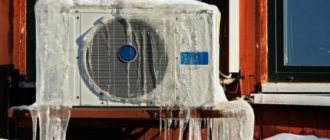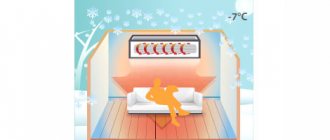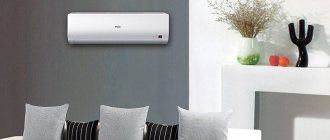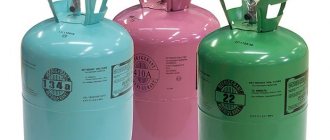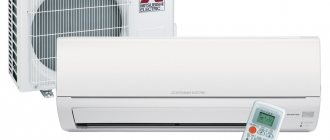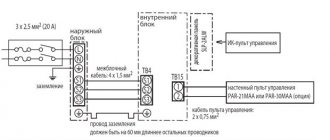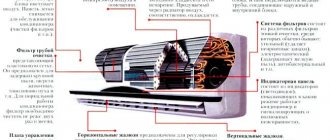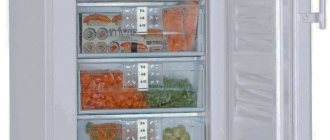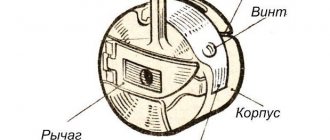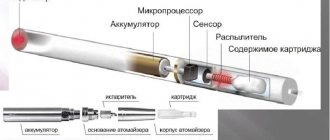When cold weather sets in, happy owners of air conditioners or their potential buyers, choosing a suitable model, begin to ask quite natural questions: is it possible to turn on the split system in rain, snow and, in general, use the device in cold weather, and whether such experiments are fraught with undesirable consequences.
Modern models of climate control equipment, with some restrictions, can be used in cold weather conditions, and a winter kit for an air conditioner will expand the performance characteristics of the split system. We will discuss these issues in more detail below.
Operating principle of household climate control equipment
The operating modes of the air conditioner, which are responsible for heating and cooling the room, operate thanks to the refrigerant, which serves as a conductor between street and home heat. In other words, household split systems themselves cannot reproduce it, but as pumps they only pump warm air into the room from the street and vice versa. Heat transfer occurs through special types of freons, and air exchange between them and the environment is carried out by air heat exchangers.
In this case, the heat performance depends both on the design of the heat exchanger, which is different for certain models of air conditioners, and on the initial temperature of the air that is passed through it.
The compressor, located in the outer casing of the device, is responsible for distributing the refrigerant throughout the device. The oil helps him with this, as it begins to thicken in the cold. As a result, the compressor mechanism operates without lubrication, and its spare parts wear out ahead of time.
Operating principle of the air conditioner
There are certain rules for operating an air conditioner in winter, failure to comply with which will lead to its breakdown, and this is often caused by water hammer. When the heating mode is turned on, the freon is heated and evaporates, however, due to excessively low temperature indicators, it does not have time to do this and the liquefied one penetrates the compressor valves.
Ambient temperature and humidity are interconnected - when one indicator changes, the other automatically changes. As a result, the volume of condensate released by the split system increases. It is removed from the device through a special drainage pipe, which, when the temperature drops greatly, becomes covered with ice inside. The condensation has nowhere to drain and it either begins to ooze out from the internal housing, or completely renders the air conditioner unusable.
It is permissible to use a household climate control device in winter, when the operating instructions for the air conditioner allow it, but in the meantime, observing all the precautions specified in it.
Heating work in winter
In addition to the above, using an air conditioner for heating in winter is associated with one more nuance. When thermal energy is taken from cold street air, it cools even more. As a result, the block on the street is covered with an additional layer of ice and snow, which are formed during this process.
The principle of operation of an air conditioner for heating
If the manufacturer allows you to run the air conditioner in winter for heating, then it is quite possible to turn it on. However, you need to make sure that the equipment outdoors is securely fastened, and that the fasteners used are able to withstand the weight of the ice that forms on the body. This is not ventilation in a bathhouse with natural draft, where there is no outside part. Everything is much more complicated here.
Air conditioner air direction in different modes
The operation of the air conditioner (typical split system) is designed in such a way that when turned on, it constantly pumps freon between the external unit on the street and the internal one in the room.
When “heating”, it is simply not able to take a lot of heat in winter from the cold atmosphere outside the window. Therefore, in spring, autumn or during a thaw, it can be turned on as an additional heater. However, during severe frosts it is better not to do this.
Heat distribution when heating with air conditioning
Heating function
Heating by air conditioning in winter is possible when it is initially equipped with such a function. On the remote control this mode is usually o.
Before you start using the heating system, you need to find out the lower temperature threshold at which you are allowed to turn on this function, and the air conditioner instructions will help with this.
By default, the maximum temperature usually does not exceed 0°C. But there are devices that can cope with frosts reaching -10°C and even -15°C. This is feasible thanks to a different type of freon and the ability to adjust the operation of the compressor, available in inverter devices.
Heating mode
Is it possible to turn on the air conditioner for heating in winter when the temperature outside is at the lower limit of the permissible limit? Not recommended. The thermometer can show it with an error of several degrees, which will become critical for the split system and cause it to fail.
If the device is working, there are no error marks on the remote control, but warm air is not coming in - the system probably needs time to warm up if it is frosty outside. This usually does not take more than 15 minutes.
Air conditioning cooling in winter
It may seem strange, but in some rooms it is necessary to remove heat even at low and negative temperatures outside. This applies to rooms containing high-power electrical or heating equipment. For example, server rooms and MRI rooms. But is it possible to turn on the air conditioner in winter for cooling?
Most split systems in the factory configuration are not designed to operate for cooling at low temperatures. Typically, the lower limit is within 5–10 degrees Celsius. For this application, special precision equipment is produced. But its cost is quite high. Can a regular air conditioner be used for these purposes?
Most of the units can be modified so that they cool in winter. This primarily applies to non-inverter units. The main problem with this is that due to the low temperature outside, the freon pressure in the outdoor unit decreases and its condensation becomes more difficult.
To solve this problem, an additional winter kit is installed in the outdoor unit, which regulates the condensation pressure by decreasing and increasing the fan speed. Some manufacturers even officially install winter kits at their dealerships.
Winter set
The winter kit usually includes:
- Drain heater. When working for cooling, moisture condenses in the indoor unit, which can freeze when removed outside.
- Crankcase heater. The compressor crankcase contains oil, which the heater protects from thickening.
- Fan speed controller. It can work either by measuring pressure in the system or by using an air conditioner temperature sensor mounted on the condenser.
We recommend that you read: Operating principle and installation of household mobile air conditioners
Please note that the winter kit does not help in any way when the air conditioner operates for heating in winter. Of all the above equipment, only the crankcase heater can be used in heating mode. Installation of winter kits is not provided for inverter air conditioners.
Inverter model
When you intend to use the air conditioner as the only or main source of heat for the room in winter, you should choose an inverter model. It can be used without fear in such cold temperatures that it is impossible to turn on an air conditioner for standard household use, even the most modern and expensive models and brands - down to -18...-30°C. In addition, inverter devices are much more durable, more ergonomic and provide a smaller temperature difference.
The obvious advantages of inverter devices are reflected in their cost: the price of such air conditioners is much higher than models of household systems.
Operating principle of the air conditioner
Each air conditioner has its own range of operating outdoor temperatures. Usually this is from minus 50 C to plus 35–40 C. But there are also devices designed to operate in winter with quite severe frost - down to minus 20–25 C. To definitely find out at what temperature the air conditioner can be turned on, you need to look at this parameter in data sheet for a specific model.
Operating temperatures of the air conditioner when used in winter and summer
It does not matter whether this climate control equipment is used for cooling or heating. If the device is not designed to operate at sub-zero temperatures, then the air conditioner cannot be turned on in any mode. It's all about the outer part, which is located on the street. Freezing is contraindicated for the equipment available there.
What to consider when choosing an air conditioner
When operating, the air conditioner does not produce “cold” or “heat”. It only pumps thermal energy, taking it in one place and releasing it in another. When it cools, it simply absorbs some of the heat from the room air through condensation on the heat exchanger. And then he takes it to the outside block and gives it to the street. When heating, the reverse process occurs - heat is taken outside and transferred to the room.
Indoor temperature fluctuations in winter
Modification of the split system for winter operation
The winter kit for the air conditioner is equipped with devices that prevent the refrigerant from overcooling, provide heating for the drainage line and maintain the oil in a liquefied state.
The principle of its operation is as follows:
- the crankcase heater heats the oil in the compressor, which bears the main load during startup, especially in winter; a device for heating the drainage system both from the inside and outside, allowing condensate to freely exit through the drainage pipe, preventing the formation of an ice plug;
- The temperature sensor promptly detects their decrease outside and slows down the operation of the fan on the external unit of the device, so that ice does not form in it, and at the same time problems with the reduced performance of the split system are solved.
The winter kit is installed once and then performs its functions automatically - it is activated when it gets cold. Now the information about the temperature to which the air conditioner can be turned on, written in the manual for the device, can be neglected, because the winter kit significantly expands its capabilities - on average to -15°C, and in the absence of strong wind to -20°C. The temperature range can be further increased, although this is usually not an economically justifiable measure.
Operation of an air conditioner upgraded with a winter kit is permissible at a low temperature threshold, however, this is only true for the cooling mode! When heated, everything will remain unchanged, moreover, there will be a risk of water hammer.
Additionally, a low temperature air conditioning kit can sometimes cost more than the unit itself. It is cheaper and easier to install it immediately when installing the split system. It is also worth remembering that the warranty on equipment will only apply if it was installed by service center specialists, and not by the owner himself.
Heating with a split system during cold periods
First, let's say a few words about the principles of operation of a split system. When the device operates in heating or cooling mode, electrical energy is used to transport heat between the street and the room. In summer it is removed into the atmosphere, and in winter, on the contrary, it is pumped from the street to the room.
Air conditioning heating
Is it possible to turn on the air conditioner at sub-zero temperatures for heating? Yes, you can. But you need to take into account several factors and features of a particular device. During operation in heating mode, freon in liquid form enters the outdoor unit, where it evaporates, taking away some of the heat. The compressor then pumps the gaseous refrigerant into the indoor unit, where it condenses in the evaporator, releasing the accumulated heat. This is how the air conditioner works for heating in winter.
During this process, the heat exchanger in the outdoor unit is cooled to a very low level, as a result of which moisture from the outside air pumped by the fan freezes on it. This is one of the main problems when operating an air conditioner for heating in winter.
The second problem is the increased viscosity of the oil in the compressor. Since it uses a moving mechanism, it needs lubrication. To do this, the compressor is filled with oil at the factory, which can thicken in the cold. When starting a compressor with too thick oil, it may break.
Freezing of the outdoor unit
In order to avoid negative aspects, before turning on the air conditioner for heating in winter in sub-zero weather, the following steps must be taken:
- In the instructions for the split system, find a clause about the maximum permissible temperatures. If it is lower on the street, then the device cannot be turned on.
- Make sure that the thermometer readings outside are above the minimum acceptable level.
- On the air conditioner remote control, find the button responsible for the heating mode and press it. Typically, a pictogram in the form of a stylized sun is used for designation.
- Select the desired temperature. There is no need to try to heat the room too much. The unit may not have sufficient power. It is recommended to heat the room in winter to 18–24 degrees.
We recommend that you read: How to install an air conditioner in a house with your own hands
After completing all the above steps, the heating mode is turned on. Please note that after the split system has been turned on, heating will begin after some time. For several minutes, and sometimes more than 10, the device will be prepared for operation without turning on the indoor unit. Don't be afraid, the air conditioner is not broken, you just need to wait.
Turning on the heating
Using equipment in bad weather
Respecting temperature limits, the answer to questions about precipitation, in particular, whether it is possible to turn on the air conditioner in rain or snow, is unequivocal - of course, yes. The external module of the device can only be damaged if icicles and ice fall on it. Installing a special metal canopy over it will solve this problem.
It is important to make sure that the temperature outside meets the acceptable threshold stated by the manufacturer, or that a low-temperature kit is installed, before testing the air conditioner in winter or installing it. Excessively cold weather should be a reason to postpone installation of equipment or its first start-up until the weather warms up.
Preservation of equipment for winter
If the climate control equipment is not planned to be used during cold weather, then it is necessary to prepare the air conditioner for winter, i.e., preserve it.
On a fine day, when the thermometer does not drop below +16°C, you need to turn on the equipment in ventilation mode for 1.5-3 hours so that all the moisture in the heat exchanger of the indoor module evaporates. If it is colder outside, it is recommended to use the heating mode instead of ventilation.
In addition, it is necessary to clean the split system filters from dust and dirt. You need to remove them by opening the front panel of the device, wash them with running water and soap, dry them and put them back.
Disconnect the split system from the network and remove it from the remote control to avoid battery oxidation.
It is not recommended to cover the outdoor unit of the air conditioner with moisture-resistant materials, since due to accumulating condensation, as well as the inaccessibility of solar heat, mold will soon form on the outdoor module.
What models can work for heating
A distinctive advantage of the split system, which operates for heating. is that it operates on the principle of a heat pump. That is, heating in the apartment is carried out by selecting heat with freon and transferring it from the external environment to the internal unit of the device, which, when using a fan, distributes the heat throughout the room. It is worth knowing that the device is 4 times more efficient in terms of efficiency than an electric heater.
This is due to the fact that the wasted electrical energy that the device absorbs ultimately produces 4 times more thermal energy. The most effective is considered to be an inverter device, which allows regulation of the compressor power. Some such devices are designed to operate down to minus 30 degrees.
Ballu Platinum evolution
One of the most popular is Ballu Platinum evolution. Up to how many degrees can you turn it on? This model functions for heating when it is cold outside the window down to -25 degrees. It has ice protection, as well as a combined filtration system to purify the air. It is equipped with gradual control of the power of action and convenient control via the remote control.
Electrolux monaco
Electrolux monaco is an air conditioner that works efficiently. At what temperature can the air conditioner be turned on? At temperatures up to -15 degrees in the room. It purifies the air using a specialized filter. Advantages include efficiency, reduced noise, four-way air exchange and temperature accuracy.
Cooper and Hunter winter
Cooper and Hunter winter is a split system model that is one of the innovative options. It works for cooling or heating, then you can turn on the air conditioner at a temperature when the temperature outside the walls is from 20 to +43 degrees. The advantages also include efficiency, an energy saving system, intelligent functions, warm start and auto start, night mode, which provides low noise levels, self-cleaning and protection against hypothermia.
Summarize
From the information above, it becomes clear whether it is possible to turn on the air conditioner in winter, and also when it is not justified to do so. It is better not to turn on an air conditioning device equipped with a heating function in cold weather in this mode, and if used, then strictly to the temperatures specified in the equipment manual. This will prevent premature wear of the compressor and damage to the device.
A win-win option in houses that are planned to be heated in winter on their own would be to install an inverter model.
Before using the air conditioner for cooling in winter, you should carefully study the manufacturer's recommendations. But there will not be such strict restrictions if the device is equipped with a winter kit.
For information, we suggest watching a video on installing a winter kit on an air conditioner:
Features of winter operation
How many degrees can you turn your air conditioning on in winter? As already mentioned, the minimum operating temperature of a split system is indicated in the instructions for specific equipment:
- most non-inverter split systems are designed to operate down to -5 degrees, some models up to +5;
- most inverter units are designed for operation at -10 - -15 degrees;
- Some heat pump models from leading manufacturers are designed for heating at outside temperatures down to -28 and colder.
The efficiency of a split system is highly dependent on the outside temperature. At temperatures around zero, almost any air conditioner can produce several times more heat than the electricity used.
